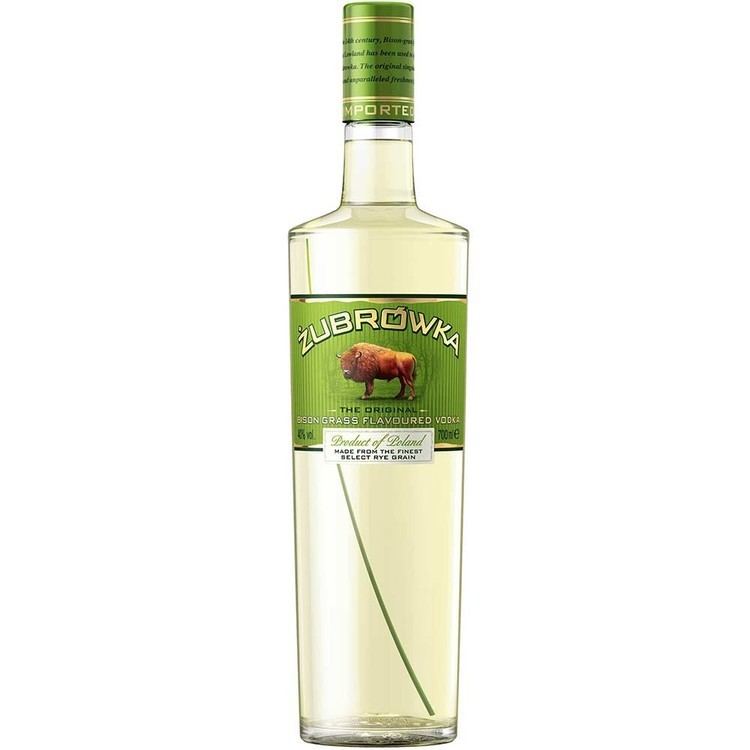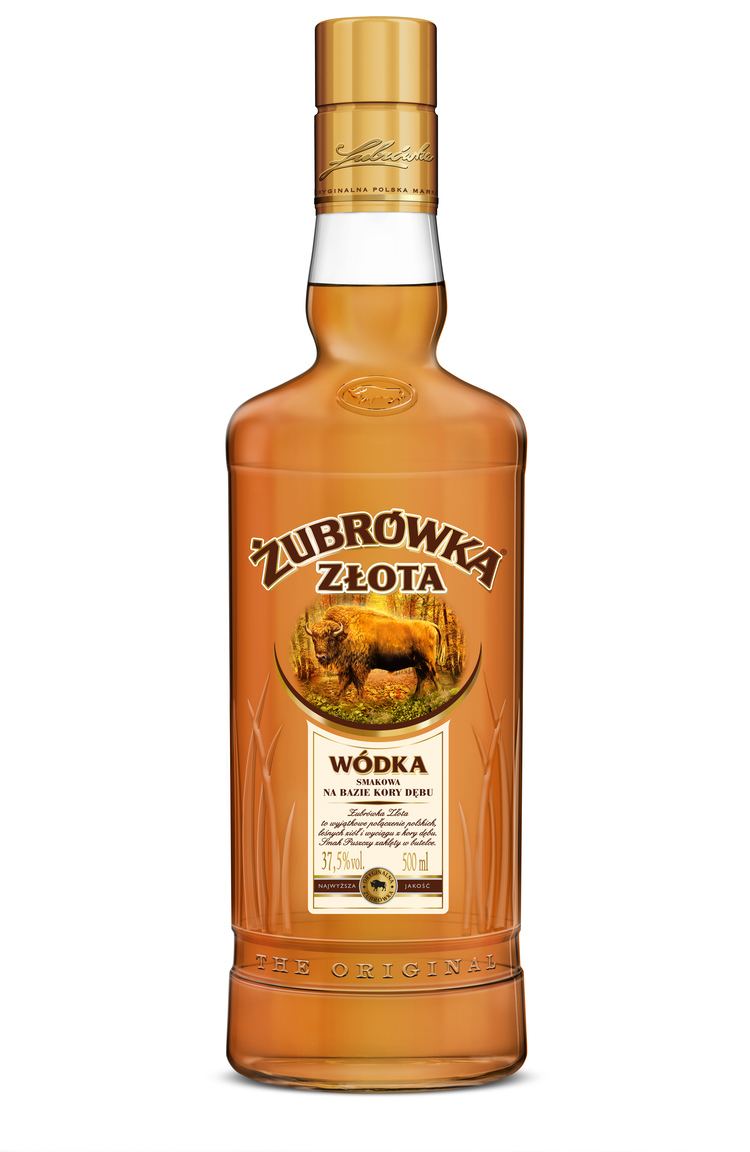Type Flavored Vodka Proof 80 Country of origin Poland | Introduced 16th century Manufacturer Polmos Białystok | |
Alcohol by volume 40% (original and biała)
37.5% (Złota)
34% (Palona) Variants Żubrówka
Żubrówka Biała
Żubrówka Palona (discontinued)
Żubrówka Złota Similar Sweet Grass, Krupnik, Vodka, Metaxa, Nalewka | ||
Lumpex 75 ubr wka
Żubrówka [ʐuˈbrufka], also known in English as Bison Grass Vodka, is a dry, herb-flavoured vodka that is distilled from rye and bottled at 40% alcohol by volume (80 US proof). Its flavour is unique and is described as having woodruff, vanilla, coconut, and almond notes.
Contents
- Lumpex 75 ubr wka
- Know your booze ubr wka bison grass vodka
- Etymology
- History
- Variants
- Popular culture
- ubrwka in the United States
- Serving suggestions
- References

The rye distillate is flavoured with a tincture of bison grass (Hierochloe odorata), which also gives the spirit its yellowish color. This grass grows in the Białowieża Forest and elsewhere. A blade of bison grass is traditionally placed in each bottle of Żubrówka, though this is largely decorative.
Know your booze ubr wka bison grass vodka
Etymology

The name Żubrówka comes from żubr (pronounced zhubr), the Polish word for the European bison, which is particularly fond of eating bison grass. The word żubr also appears in similar forms with an identical meaning in numerous other Slavic languages: Belarusian, Russian and Ukrainian зубр (zubr), Bulgarian зубър (zubŭr), Czech zubr, Slovak zubor and Slovenian zober. Although in Poland the word Żubrówka is now commonly associated with this type of vodka, in Polish the same word is used to describe bison grass—which is primarily what the vodka is named after.
History

According to the label on the bottle, Polish nobility "seasoned" vodka with bison grass as early as the 14th century; this was likely a precursor to Żubrówka. Żubrówka has been manufactured in the region of the contemporary Polish-Belarusian (Polish-Lithuanian Commonwealth) border since the 16th century, and by 18th century was one of the favorite raw drinks of nobility (szlachta) and peasantry alike.

In 1926 the Polmos company in Brześć nad Bugiem (now Belalco company, Brest, Belarus) invented a method to mass-produce Żubrówka, which was then copied by numerous companies worldwide, under a variety of brand names. The original distillery company in Brest (Belaco) still produces Brestskaya Zubrowka (Зуброўка, Zubroŭka), as do Lithuania (Stumbrinė), United States (Bison Vodka), Ukraine (Зубрiвка, Zubrivka), Germany (Grasovka and Blauer Bison), Russia (Зубровка, Zubrovka), the Czech Republic (Zubrovka), and many other countries. However, versions of the beverage produced outside of the Polmos Białystok distillery in Poland are often considered "low-quality knockoffs" in comparison to the original brand.

Currently the brands "Zubrovka" and "Żubrówka" are registered by Sojuzplodoimport/Russia and the Polmos Białystok company in Białystok, Poland. However, Żubrówka is considered a generic name for a type of liquor by the U.S. Patent and Trademark Office, so anyone may use the name for products in the United States, and the name has been used by various companies there.
Variants
Popular culture
Żubrówka in the United States
The tincture of bison grass found in Żubrówka is prohibited as a food additive by the Food and Drug Administration because it contains coumarin, which showed hepatotoxic effects in rats and has a blood thinning effect. Importation of Żubrówka was banned in 1978 by the Bureau of Alcohol, Tobacco and Firearms. Canada has no similar regulations on coumarin, so the alcoholic drink is legal there.
When produced according to traditional methods (between one and two kilograms of grass per thousand litres of alcohol), Żubrówka contains approximately 12 milligrams of coumarin per litre. In 1999, distilleries that were not connected with the Polish brand introduced lower quality reformulated versions of the product, sometimes using artificial flavours and colors, with the emblematic blade of grass in every bottle but "neutralised" so as to be coumarin-free. In 2011 the American licensee of the Polish company worked with Rémy Cointreau to introduce a new American formulation, which they called "Żu".
In addition to the Coumarin problem, American authorities determined that the trademark on Żubrówka brand was diluted and unenforceable, as it was a generic name, like "Aspirin".
Serving suggestions
Like most vodkas, Żubrówka is usually served chilled on its own. A very popular alternative is mixing it with apple juice (a drink known in Polish as tatanka (Lakota for "American bison") or szarlotka (Polish for "apple cake"); known in the UK as a Frisky Bison; and in the US as a Polish Kiss). It is sometimes served over vanilla ice cream. Another common mixer is ginger ale. Żubrówka also goes well with mango juice or pineapple juice
